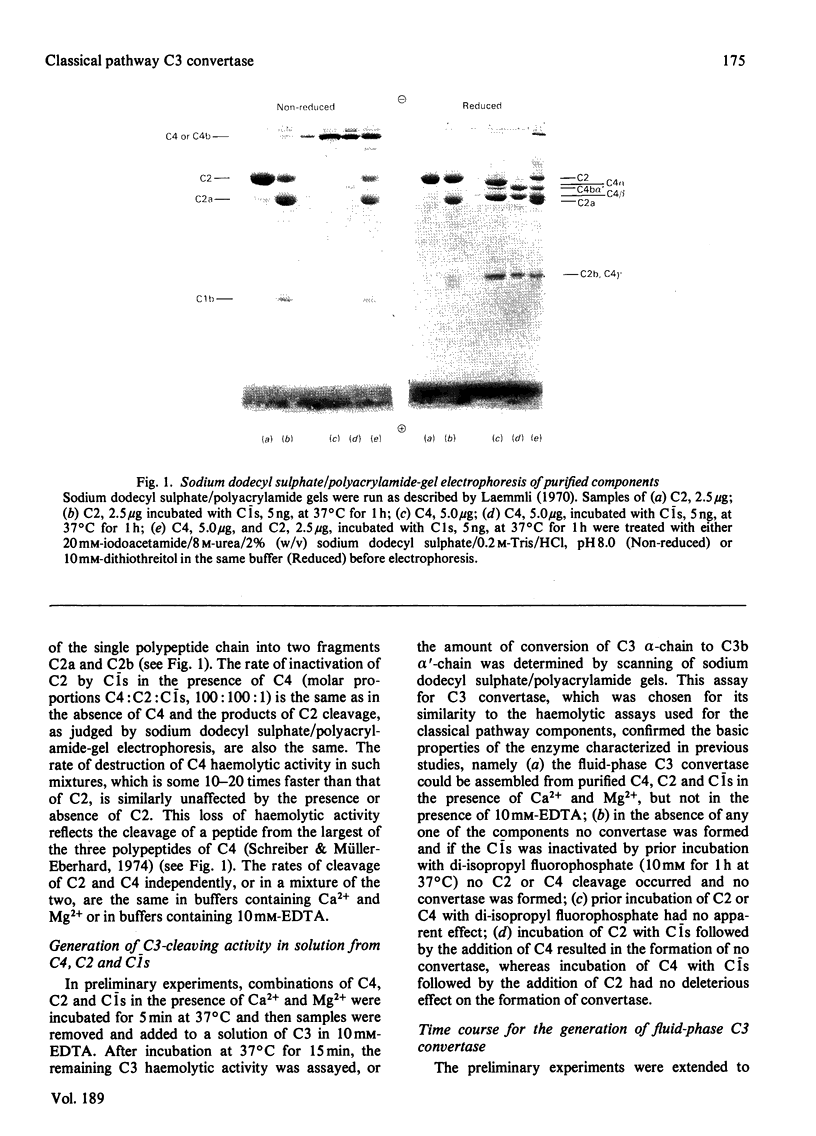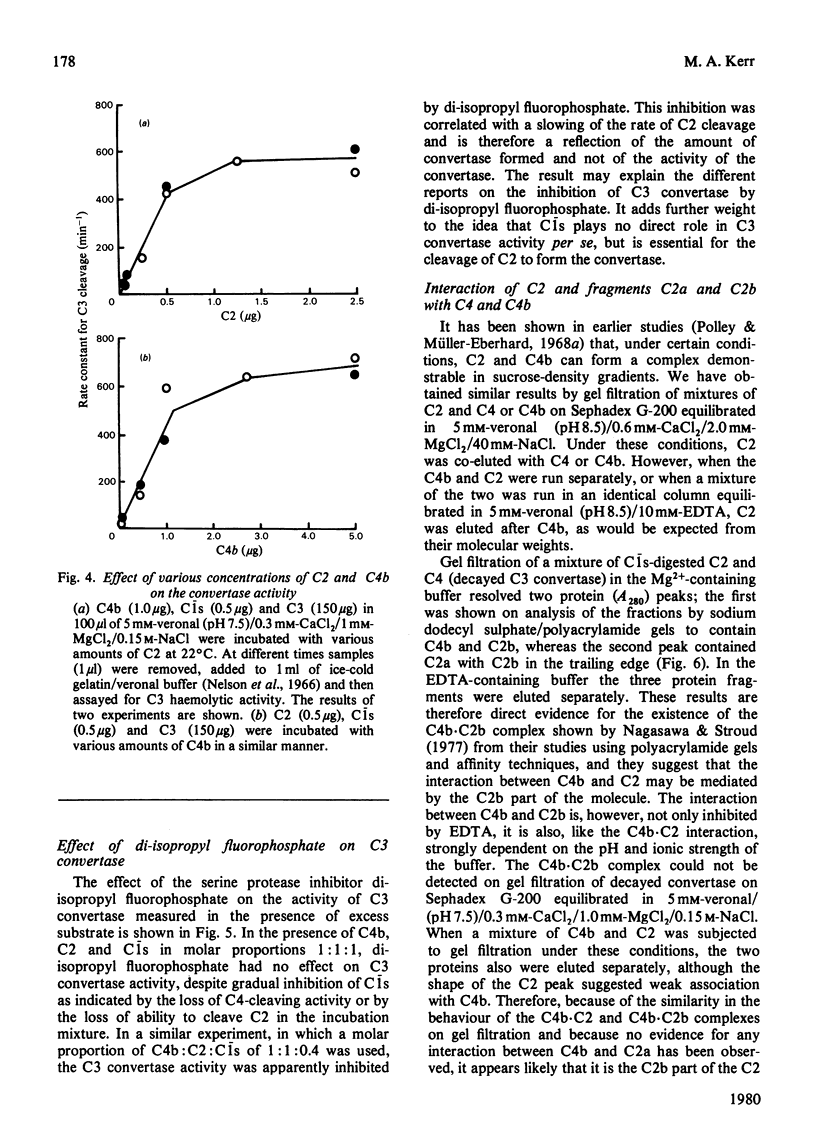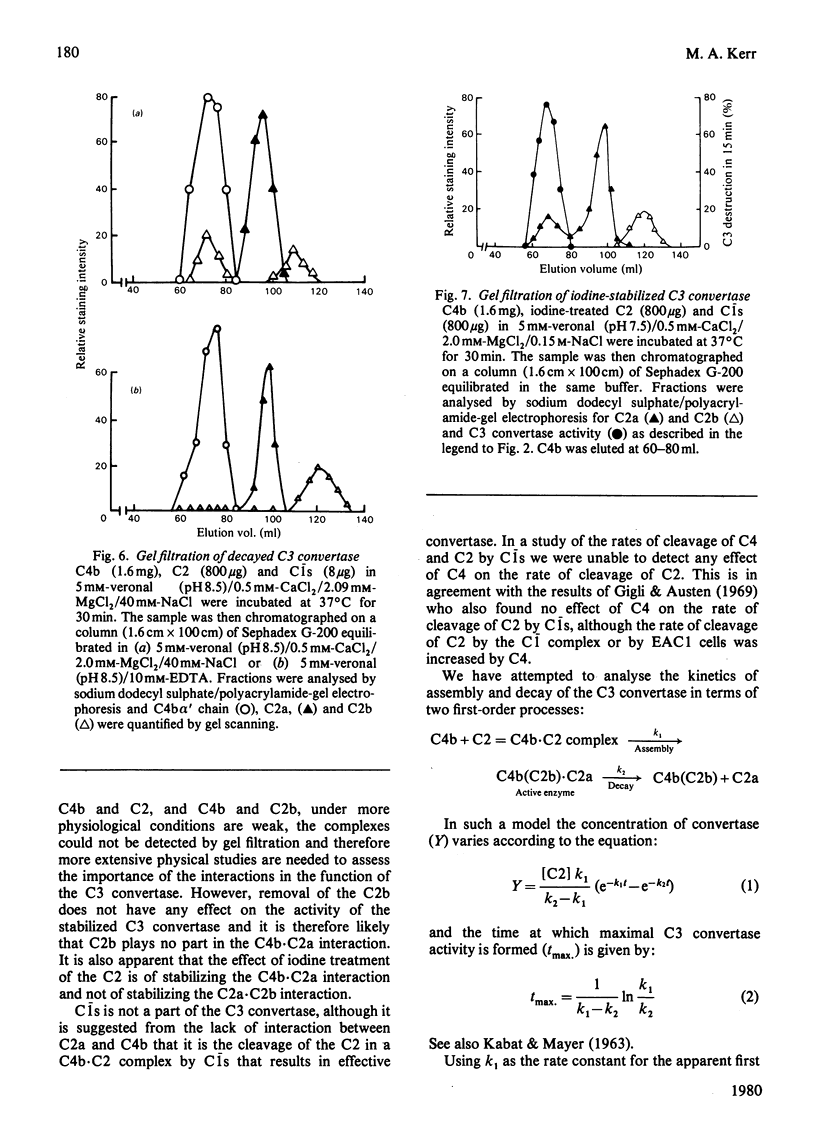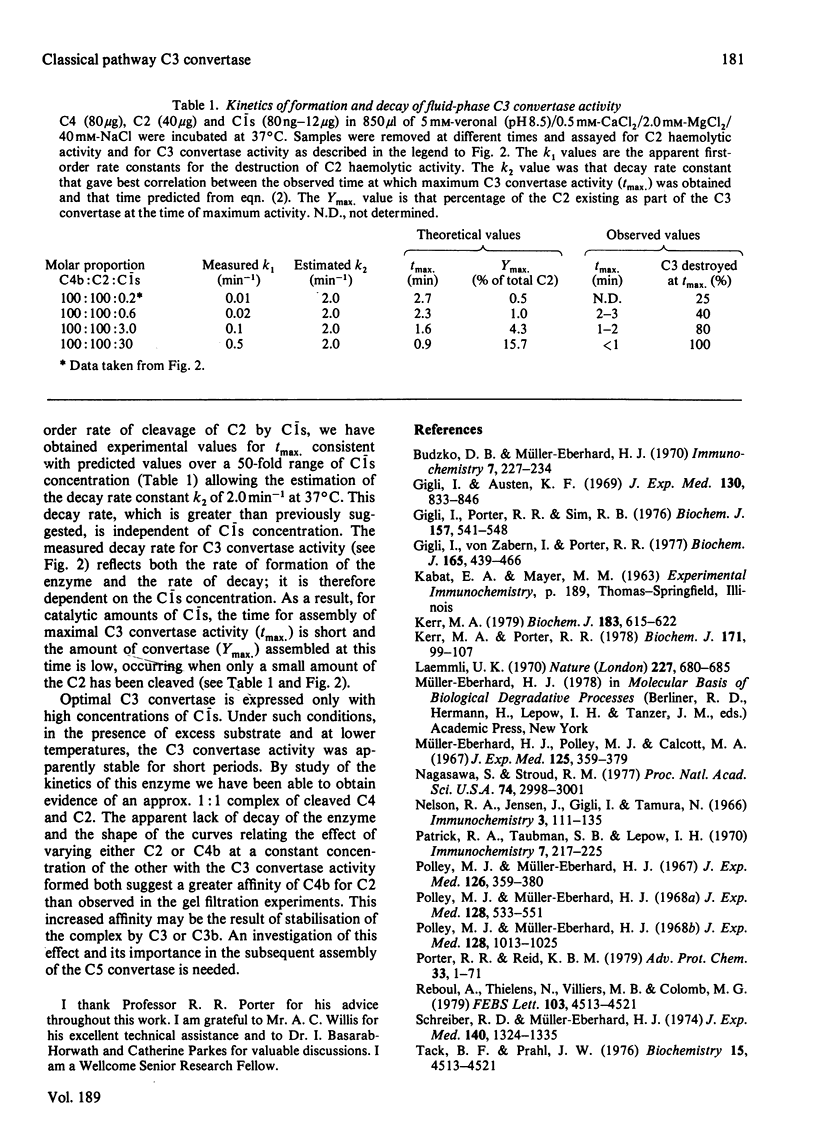Abstract
The assembly of the classical pathway C3 convertase in the fluid phase has been studied. The enzyme is assembled from C2 and C4 on cleavage of these proteins by C1s. Once assembled, the enzyme activity decays rapidly. Kinetic evidence has been obtained that this decay is even more rapid than previously suggested (kdecay is 2.0 min-1 at 37 degrees C). As a result, optimal C3 convertase activity is only observed with high C1s levels, which result in rapid rates of cleavage of C2 and increased rates of formation of the C3 convertase. Using high concentrations of C1s at lower temperatures (22 degrees C) in the presence of excess substrate we have demonstrated kinetically that the enzyme comprises an equimolar complex of C4b and cleaved C2. We have obtained direct evidence from gel-filtration experiments for the role of C2a as the catalytic subunit of the enzyme. C2b appears to mediate the interaction between C4 (or C4b) and C2 at pH 8.5 and at low ionic strength where the interactions can easily be detected. It may therefore be important in the assembly of the enzyme, though it is not involved in the catalytic activity. The decay of the C3 convertase reflects the release of C2a from the C4b x (C2b) x C2a complex, and the stabilizing effect of iodine on the C3 convertase is therefore apparently one of stabilizing the C4b-C2z interaction, which is otherwise weak. C1s is not a part of the C3 convertase enzyme.
Full text
PDF








Images in this article
Selected References
These references are in PubMed. This may not be the complete list of references from this article.
- Budzko D. B., Müller-Eberhard H. J. Cleavage of the fourth component of human complement (C4) by C1 esterase: isolation and characteristics of the low molecular weight product. Immunochemistry. 1970 Feb;7(2):227–234. doi: 10.1016/0019-2791(70)90158-8. [DOI] [PubMed] [Google Scholar]
- Gigli I., Austen K. F. Fluid phase destruction of C2hu by C1hu. II. Unmasking by C4ihu of C1hu specificity for C2hu. J Exp Med. 1969 Oct 1;130(4):833–846. doi: 10.1084/jem.130.4.833. [DOI] [PMC free article] [PubMed] [Google Scholar]
- Gigli I., Porter R. R., Sim R. B. The unactivated form of the first component of human complement, C1. Biochem J. 1976 Sep 1;157(3):541–548. doi: 10.1042/bj1570541. [DOI] [PMC free article] [PubMed] [Google Scholar]
- Gigli I., von Zabern I., Porter R. R. The isolation and structure of C4, the fourth component of human complement. Biochem J. 1977 Sep 1;165(3):439–446. doi: 10.1042/bj1650439. [DOI] [PMC free article] [PubMed] [Google Scholar]
- Kerr M. A. Limited proteolysis of complement components C2 and factor B. Structural analogy and limited sequence homology. Biochem J. 1979 Dec 1;183(3):615–622. doi: 10.1042/bj1830615. [DOI] [PMC free article] [PubMed] [Google Scholar]
- Kerr M. A., Porter R. R. The purification and properties of the second component of human complement. Biochem J. 1978 Apr 1;171(1):99–107. doi: 10.1042/bj1710099. [DOI] [PMC free article] [PubMed] [Google Scholar]
- Laemmli U. K. Cleavage of structural proteins during the assembly of the head of bacteriophage T4. Nature. 1970 Aug 15;227(5259):680–685. doi: 10.1038/227680a0. [DOI] [PubMed] [Google Scholar]
- Müller-Eberhard H. J., Polley M. J., Calcott M. A. Formation and functional significance of a molecular complex derived from the second and the fourth component of human complement. J Exp Med. 1967 Feb 1;125(2):359–380. doi: 10.1084/jem.125.2.359. [DOI] [PMC free article] [PubMed] [Google Scholar]
- Müller-Eberhard H. J., Polley M. J., Calcott M. A. Formation and functional significance of a molecular complex derived from the second and the fourth component of human complement. J Exp Med. 1967 Feb 1;125(2):359–380. doi: 10.1084/jem.125.2.359. [DOI] [PMC free article] [PubMed] [Google Scholar]
- Nagasawa S., Stroud R. M. Cleavage of C2 by C1s into the antigenically distinct fragments C2a and C2b: demonstration of binding of C2b to C4b. Proc Natl Acad Sci U S A. 1977 Jul;74(7):2998–3001. doi: 10.1073/pnas.74.7.2998. [DOI] [PMC free article] [PubMed] [Google Scholar]
- Nelson R. A., Jr, Jensen J., Gigli I., Tamura N. Methods for the separation, purification and measurement of nine components of hemolytic complement in guinea-pig serum. Immunochemistry. 1966 Mar;3(2):111–135. doi: 10.1016/0019-2791(66)90292-8. [DOI] [PubMed] [Google Scholar]
- Patrick R. A., Taubman S. B., Lepow I. H. Cleavage of the fourth component of human complement (C4) by activated Cls. Immunochemistry. 1970 Feb;7(2):217–225. doi: 10.1016/0019-2791(70)90157-6. [DOI] [PubMed] [Google Scholar]
- Polley M. J., Müller-Eberhard H. J. The second component of human complement: its isolation, fragmentation by C'1 esterase, and incorporation into C'3 convertase. J Exp Med. 1968 Sep 1;128(3):533–551. doi: 10.1084/jem.128.3.533. [DOI] [PMC free article] [PubMed] [Google Scholar]
- Porter R. R., Reid K. B. Activation of the complement system by antibody-antigen complexes: the classical pathway. Adv Protein Chem. 1979;33:1–71. doi: 10.1016/s0065-3233(08)60458-1. [DOI] [PubMed] [Google Scholar]
- Schreiber R. D., Müller-Eberhard H. J. Fourth component of human complement: description of a three polypeptide chain structure. J Exp Med. 1974 Nov 1;140(5):1324–1335. doi: 10.1084/jem.140.5.1324. [DOI] [PMC free article] [PubMed] [Google Scholar]
- Tack B. D., Prahl J. W. Third component of human complement: purification from plasma and physicochemical characterization. Biochemistry. 1976 Oct 5;15(20):4513–4521. doi: 10.1021/bi00665a028. [DOI] [PubMed] [Google Scholar]



